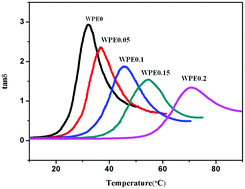Structure design, fabrication and property investigation of water-based polyesters with notable surface hydrophilicity
Abstract
Environmentally friendly waterborne polyesters (WPEs) were obtained by copolymerization of diethylene glycol (DEG), isophthalic acid (IPA) and 5-sulfoisophthalic acid monosodium salt (5-SSIPA). The effects of the 5-SSIPA content on the properties of the resultant copolymers, including dispersity, crystallinity, dynamic thermo-mechanical properties, thermal stability and surface properties, were investigated. The 5-SSIPA contents in the intended polymers were determined by the peak areas of proton nuclear magnetic resonance (1H-NMR) spectra. Transmission electron microscopy (TEM), electrophoretic light scattering (ELS) and dynamic light scattering (DLS) were used to characterize the dispersion and stability performance of waterborne polyester solutions. The crystallinity of the WPEs was determined using X-ray diffraction (XRD) and differential scanning calorimetry (DSC). As the 5-SSIPA content increased, the glass-transition temperature (Tg) of the WPEs increased significantly according to dynamic mechanical analysis (DMA), the thermal stability of the WPEs was deteriorated according to thermogravimetric analysis (TGA), surface roughness did not change according to atomic force microscopy (AFM), and their solid surface tension was increased from 28.47 to 32.90 mJ m−2 based on static contact angle measurements. Water contact angle (WCA) measurements proved that WPE dispersions could be used for enhancing the hydrophilicity of the PET surface.



 Please wait while we load your content...
Please wait while we load your content...